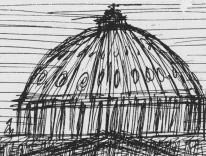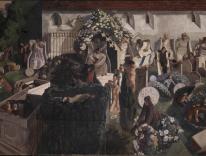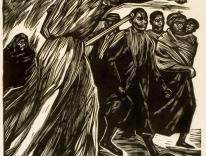Heaven’s Bride
The Unprintable Life of Ida C. Craddock, American Mystic, Scholar, Sexologist, Martyr, and Madwoman
Leigh Eric Schmidt
Basic Books, $28.95, 335 pp.
Padre Pio
Miracles and Politics in a Secular Age
Sergio Luzzatto
Translated by Frederika Randall
Metropolitan Books, $35, 384 pp.
Though sex and stigmata form two poles of human experience—one anchored in the carnal union of human beings, the other issuing from the spiritual joining of human and divine—the rapture of sexual union can point to heavenly realities, just as the sanctity of stigmata can speak to more worldly concerns. Such insights inform the seductions offered by two remarkable new books. Heaven’s Bride chronicles the “unprintable life” of Ida Craddock (1857–1902), the American freethinker and self-proclaimed mystic considered by some a martyr for free speech. Padre Pio addresses the life of the revered Capuchin stigmatist of San Giovanni Rotondo in southern Italy. Ida Craddock died alone, by her own hand, while Padre Pio passed away (in 1968) after having been publicly acknowledged as a living saint. But despite their divergent earthly trajectories, the lives of Ida Craddock and Padre Pio reveal the unexpectedly close relationship between sex and stigmata.
Heaven’s Bride paints a vivid portrait of an idealistic reformer whose idiosyncrasies reflected the hopes and anxieties of turn-of-the-century America. Harvard historian Leigh Eric Schmidt begins his study of Craddock near the end of her life, with her arrest for obscenity by Anthony Comstock of the New York Society for the Suppression of Vice. Schmidt then circles back through Craddock’s early years to chart her burgeoning interest in reshaping American attitudes toward sexuality.
As one of her friends wryly remarked, Craddock had “a self-destructive impulse ‘to impart knowledge without discrimination.’” She defended a belly-dancing display at the Columbian Exposition as a “religious memorial” that represented the “apotheosis of female passion.” She advocated primeval phallic worship as a path to “erotic redemption.” Most spectacularly, she claimed to have been tutored in the amative arts by an angel named Soph, the spirit of a deceased suitor she had once spurned. As a sexologist who counseled couples on the spiritual and physical intricacies of “right marital living,” Craddock advocated the separation of sex from procreation and promoted male continence—not only to prolong the pleasure of the woman but also to lead the man to the mystical ecstasy of orgasm without ejaculation.
As Schmidt remarks, Ida Craddock was “out there on a limb”—and yet, he informs us, “she had plenty of company.” This company included such well-known figures as the activist Elizabeth Cady Stanton and the lawyer Clarence Darrow, as well as journalists and editors ranging from William T. Stead of the Pall Mall Gazette to Moses Harman of Lucifer the Light-Bearer. Craddock led a peripatetic life, moving from Philadelphia to such far-flung places as San Francisco, Denver, and London, and settling for a time in New York City, Washington D.C., and Chicago—always trying to stay ahead of authorities who accused her of purveying “filth.” It was Anthony Comstock, using his position as a special postal inspector, who finally entrapped Craddock for distributing her “obscene” marriage pamphlets through the mail. Facing five years in prison, Craddock committed suicide, inhaling gas and slitting her left wrist. She got the last word in the form of her suicide note, which contained a furious denunciation of Comstock as a “sex pervert” and “sadist” and helped establish “Comstockery” as vernacular shorthand for hysterical moralizing and censorship.
Padre Pio, famed in his time not only for stigmata but for other miraculous gifts ranging from levitation to prophecy, was also a wildly controversial figure. Indeed, University of Turin professor Sergio Luzzatto manages to dig up enough dirt on Padre Pio to obscure the Capuchin friar’s halo in a dust cloud. Born Francesco Forgione in Campania in 1887, Padre Pio was hospitalized during World War I, allegedly for a “self-injury” (his followers would later interpret it as an instance of transverberation). According to Luzzatto, this was only the beginning of a long train of dubious actions. During the run-up to World War II, Padre Pio and his fellow Capuchins in San Giovanni apparently had amicable relationships with a collection of fascist officials, spies, and financial double-dealers. And as his fame grew, his vow of poverty was relaxed sufficiently for him to accept substantial donations made by pilgrims. Luzzatto has also unearthed written documentation that Padre Pio asked a pharmacist to surreptitiously procure carbolic acid and a painkiller—a way, perhaps, to produce stigmata, should mystical rapture fail to work. For his part, Padre Pio always maintained that the carbolic acid in his possession was for the sterilization of syringes—and the Vatican has judged these and similar accusations against Pio to be without merit.
Luzzatto’s deconstruction of Padre Pio will interest some and infuriate others. For me, its least attractive aspect is a tendency to portray Padre Pio’s admirers as either brazen profiteers or clueless bumpkins. Regardless of whether one views the Capuchin friar as a saint or a sham, it is indisputably clear that many people realized complex and meaningful experiences through their connection with him. Be that as it may, Luzzatto is quite brilliant in explicating how the cult of Padre Pio reflected and refracted dynamics within Italian society and the Roman Catholic Church. After the first appearance of the stigmata in 1918, Padre Pio became favored by the mutilati veterans of World War I who saw their own woundedness sacralized in and through the friar’s stigmata. In a society rent by communism and fascism, the stigmatic body of Padre Pio became a potent rallying point for those defending “faith and fatherland.” Luzzatto also assesses a Catholic Church caught in the transition Italy was undergoing from an agricultural society to an industrial one, and argues that the Padre Pio phenomenon combined a need to hold onto the premodern past with a postmodern expectation that the sacred be linked to spectacle.
Treated with suspicion by Benedict XV and Pius XI, Padre Pio in his role as an Italian alter Christus was received more positively by media-savvy Pius XII. Ecclesiastical currents again shifted under John XXIII, who, informed of seemingly credible evidence of sexual misconduct involving Padre Pio, wrote in his diary of “a calamity diabolically prepared to discredit the Holy Church.” The restrictions he placed upon Padre Pio were criticized in the press and eventually relaxed by Paul VI. But after Padre Pio’s death in 1968, his cause languished until the election of John Paul II. By canonizing Padre Pio, John Paul II was not just recognizing Padre Pio’s sanctity—a sanctity that the pope had himself experienced during a pilgrimage to San Giovanni Rotondo decades earlier—but was also restoring an image of the church as “the mystical body of Christ.” In death, as in life, the stigmatic body of Padre Pio became a focal point for envisioning how earthly forms of order could mirror eternal realities.
If hindsight gives us a fuller picture of a person’s significance, it might seem appropriate to canonize Ida Craddock as well. But, as Schmidt makes clear in Heaven’s Bride, to cast her as a patron saint of contemporary forms of sexual liberation would be to ignore her emphasis on matrimony and monogamy, as well as her disgust with masturbation, oral sex, and same-sex coupling. Such aversions reflect Craddock’s belief in the complementarity of male and female bodies in accordance with the metaphysical order of the universe. Of course, Padre Pio’s stigmata also evoked complementarity, giving witness to the interpenetration of human and divine love.
Because both sex and stigmata are related to the proper ordering of the body, it is not surprising that both Craddock and Padre Pio were viewed as political actors—after all, politics is concerned with deploying human bodies in the service of broader ideological understandings about the proper order of things. Both books leave room for readers to form opinions about the extent to which Craddock and Pio understood the broader implications of their personal forms of “embodiment.” Schmidt concludes his discussion by critically examining psychological studies that pronounced Craddock insane; Luzzatto surveys a number of church inquisitors who labeled Padre Pio a saint, a simpleton, and a psychopath. Regardless of where one finally comes down on questions of sanity, sanctity, and chicanery, these two fascinating books reveal sex and stigmata as potent means for reimagining and remaking both self and society.
Related: The Legacy, by Bruce Murphy


